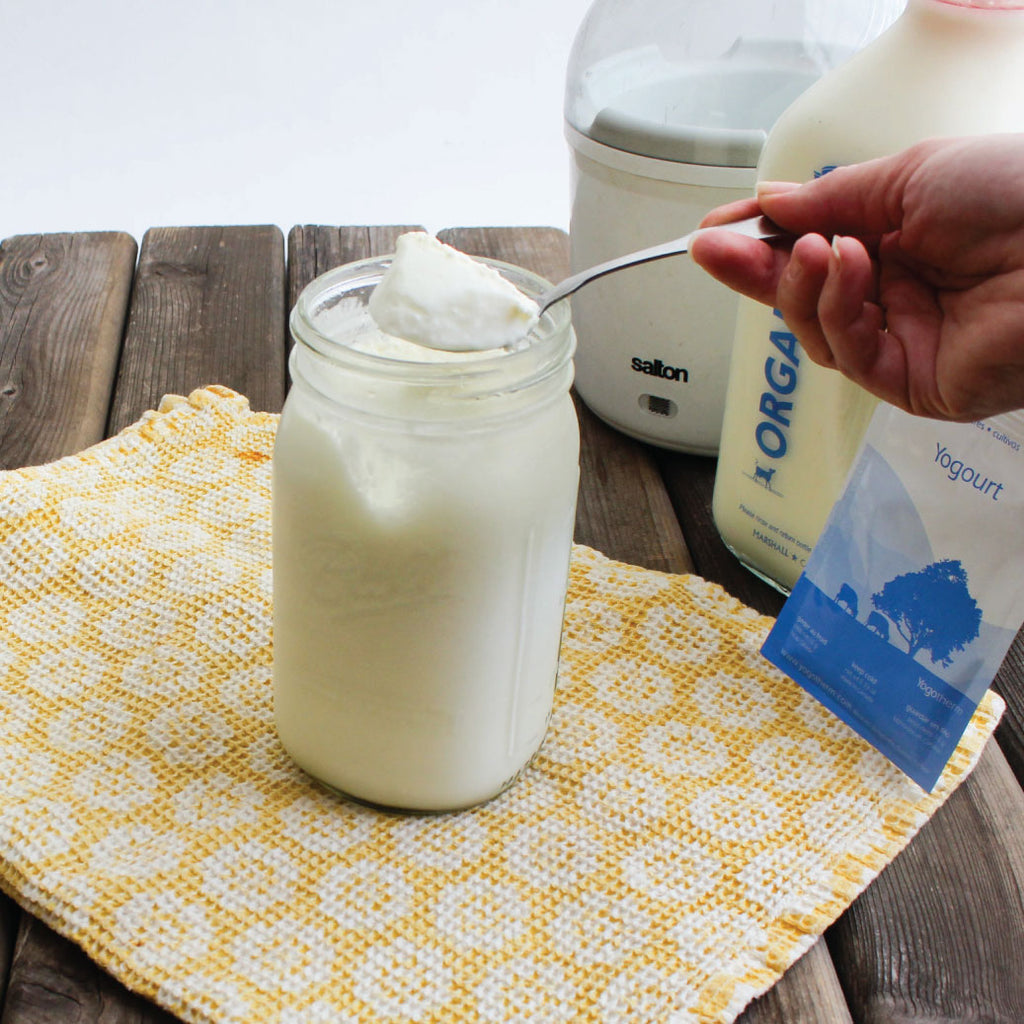
You can use either raw or pasteurised milk and semi-skimmed or whole milk. The simplest option is to drain whey from the yogurt using butter muslin or a tight-weave cloth.

Whole milk will give you a thicker creamier yoghurt.
Milk for yogurt making. Fresh milk is inoculated with thermophilic heat-loving beneficial bacteria. The bacteria culture the yogurt by eating milk sugars and making lactic acid. As the lactic acid builds up in the milk the pH drops until eventually the milk proteins coagulate into the soft tangy curd we know and love as yogurt.
Boiling of the milk evaporate the water in the milk. All milks contain some water. After the fermentation you will notice some whey left.
Once the milk has reached 115F you will add 2 tablespoons of pre-made yogurt to each quart of milk. The yogurt can come from either a previous batch if youve already made some or from store-bought yogurt. You can also use a store-bought yogurt culture but using pre-made yogurt is easier and less expensive.
Milk is an essential ingredient in the yogurt making process and you can consider using several options. You can make yogurt with ultra pasteurized milk but it can impart a slightly cooked flavor to your yogurt. That change is due to how ultra pasteurized milk is prepared and packaged.
Something that comes up again and again in our conversations about homemade yogurt is how to make it thicker more like store-bought. Thin runny yogurt loses its appeal really fast so lets talk optionsFirst off take a look at the kind of milk youre using. While you can technically make yogurt with whole 2 or non-fat milk a higher fat content will definitely give you a thicker.
You can use either raw or pasteurised milk and semi-skimmed or whole milk. Whole milk will give you a thicker creamier yoghurt. For the most part the time involved in making yogurt is inactive so its an easy project to fit into your day.
Heres what youll need to get started. Ideally a slow cooker with a removable crock this is hands down your easiest and best option. However you can also make yogurt by heating your milk on the stove in a pan.
Back home let the ready-made yoghurt come to room temperature pour the milk into a saucepan and whisk in 25g powdered milk if using for every 500ml of milk. Raw milk generally makes yogurt that has a much thinner consistency than yogurt made with pasteurized milk. There are several ways to thicken raw milk yogurt.
The simplest option is to drain whey from the yogurt using butter muslin or a tight-weave cloth. Follow your normal milking routine to get fresh milk from your jersey milking cow. You will need at least a half-gallon of milk to make a half cup of yogurt so plan accordingly.
Pasteurize the milk and then add culture to get it to the right consistency. How To Make Yogurt At Home. To make yogurt you need two ingredients milk and a yogurt starter plus some basic kitchen equipment and utensils.
Milk For Making Yogurt. Yogurt can be made with a number of different types of milk but the best milk for making yogurt is a milk. To make yogurt in a machine that has seven 6-ounce containers you will need 42 ounces 5 14 cups of milk whole or 2 percent milk work best and 6 ounces of plain yogurt containing live active cultures.
It is very important to use fresh plain unflavored yogurt and the freshest best-quality milk you can find. Option 1 you can use raw milk from your dairy animals heat it up a bit add a yogurt starter culture and culture your milk for a few hours. This will produce a thin kind of yogurt that is mostly drinkable.
If you choose to do this its better if you use a yogurt starter culture from. I like to find milk when its been discounted because its getting ready to go off. This is a great way to make yogurt much cheaper than buying it.
Also you can use goats milk to make your homemade yogurt as well. Plus you can use any storebought yogurt you wish to make homemade yogurt. Greek yogurt or regular yogurt will work.
While there are many types and flavors of milk yogurt available in grocery stores making your own yogurt is simple. Im making yogurt using my MILs old Salton yogurt maker. My usual process is to heat the milk to 180 cool to 120 then mix in starter and pour into maker.
However I wasnt quite paying attention and the milk heated to 200. So long as I cool it to 120 will it still work. I dont want to waste milktime if Ive messed it up somehow.